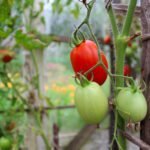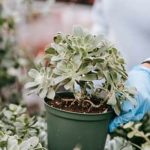When it comes to vegetable gardening, choosing the right pot size is crucial for the success of your plants. The pot size for vegetable gardening can have a significant impact on the growth and yield of your vegetables. In this article, we will explore how to decide the best container for your vegetables, understand the importance of pot size in vegetable gardening, and discuss factors to consider when selecting pot size.
The pot size plays a critical role in the overall health and development of your vegetable plants. Understanding how it affects growth and yield is essential for any gardener looking to maximize their harvest. Factors such as the type of vegetable you are growing and the space available will also influence your decision when it comes to pot size.
Maintaining optimal growing conditions is vital for the success of your vegetable garden, and pot size plays a significant role in this. The impact of pot size on soil moisture and nutrient levels is an important consideration for any gardener. Additionally, knowing when and how to repot your vegetables, as well as best practices for filling and preparing different pot sizes, will ensure that your plants have adequate drainage and room for root growth.
Understanding the Importance of Pot Size in Vegetable Gardening
When it comes to vegetable gardening in containers, the size of the pot plays a crucial role in determining the success of your crop. The pot size for vegetable gardening affects the growth and yield of your plants in several ways, making it essential to choose the right container for your vegetables.
One factor to consider when understanding the importance of pot size in vegetable gardening is root space. A larger pot provides more room for the roots to spread out and access necessary nutrients and water, leading to healthier and more productive plants. On the other hand, using a pot that is too small can restrict root growth, ultimately stunting the plant’s development and reducing its yield.
Another important aspect impacted by pot size is soil moisture levels. Larger pots retain more soil moisture, reducing the frequency of watering and providing a more stable environment for plant growth. In contrast, smaller pots dry out quickly and may require more frequent watering, leading to fluctuations in soil moisture levels that can stress the plants and affect their overall health.
In addition to root space and soil moisture, pot size also affects nutrient levels. Larger pots have a greater volume of soil, allowing for better nutrient retention and reducing the risk of nutrient deficiencies.
Alternatively, smaller pots have limited soil volume, which can lead to faster depletion of nutrients and may require more frequent fertilization to support healthy plant growth. Understanding these impacts on growth and yield emphasizes the importance of selecting an appropriate pot size for your vegetable container garden.
Factors to Consider When Selecting Pot Size
When it comes to choosing the right pot size for your vegetable gardening, there are several factors to consider in order to ensure the optimal growth and yield of your plants. One of the most important considerations is the type of vegetable you plan to grow.
Different vegetables have varying root depths and spacing requirements, which will directly impact the size of the pot needed for successful growth. For example, larger vegetables such as tomatoes or peppers will require a larger pot size compared to smaller herbs or lettuce.
Another crucial factor to take into account is the space available for your container gardening. If you have limited space, you may need to opt for smaller pots that can be easily arranged on balconies or small patios.
Alternatively, if space is not an issue, you can select larger pots that will provide more room for root development and water retention. Additionally, consider whether you want to grow one type of vegetable per pot or if you’d like to create a mixed container garden with multiple varieties.
In addition to considering the type of vegetable and available space, it’s essential to think about how often you will be able to water and maintain your potted plants. Smaller pots dry out faster than larger ones, so if you have a busy schedule or live in a hot climate, you may need to choose larger pot sizes to ensure adequate moisture levels for your vegetables.
On the other hand, if you are growing in a cooler environment or can dedicate more time to plant care, smaller pots may suffice.
| Factor | Consideration |
|---|---|
| Type of Vegetable | Different vegetables have varying root depths and spacing requirements |
| Space Available | Limited space may require smaller pots while larger spaces can accommodate bigger pots |
| Maintenance Frequency | Smaller pots dry out faster so consider how often you can water and maintain your plants |
The Impact of Pot Size on Soil Moisture and Nutrient Levels
When it comes to container gardening, the size of the pot can have a significant impact on the moisture and nutrient levels in the soil. Understanding how pot size affects these crucial growing conditions is essential for maintaining healthy and productive vegetable plants.
One of the key ways in which pot size influences soil moisture and nutrient levels is through the amount of space available for root growth. In smaller pots, the limited space can lead to faster drying out of the soil and depletion of nutrients, especially for larger or more demanding vegetables. On the other hand, larger pots provide more room for root development, allowing for better water retention and access to nutrients in the soil.
To maintain optimal growing conditions for your vegetables, it’s important to choose the right pot size based on the specific needs of each type of vegetable. Factors such as the mature size of the plant, its root structure, and its watering requirements should all be taken into consideration when selecting a pot size. Additionally, monitoring soil moisture levels and regularly fertilizing according to the needs of each crop are essential practices for maintaining healthy nutrient levels in container gardening.
Here are some tips for maintaining optimal soil moisture and nutrient levels based on different pot sizes:
- In smaller pots (6-10 inches in diameter), consider using moisture-retaining potting mix and adding organic matter such as compost or peat moss to improve water retention.
- For medium-sized pots (12-18 inches in diameter), ensure adequate drainage by using containers with drainage holes at the bottom to prevent waterlogging that can lead to nutrient leaching.
- In larger pots (20 inches or more in diameter), use a balanced blend of slow-release fertilizer to provide consistent nutrients over an extended period, reducing the need for frequent fertilization.
By understanding how pot size affects soil moisture and nutrient levels, you can make informed decisions when choosing containers for your vegetable garden and implement practices that will help maintain optimal growing conditions for your crops.
Upsizing and Downsizing
When it comes to container gardening, choosing the right pot size for your vegetables is crucial for their growth and yield. But what happens when your plants outgrow their current pots? It’s important to know when and how to repot your vegetables for maximum growth.
One sign that your plants may need repotting is if you notice roots growing out of the drainage holes at the bottom of the pot. This indicates that the plant has outgrown its current container and needs more space to spread its roots. Another indication is if you see stunted growth or reduced fruit production, which can be a result of the plant being root-bound in a too-small pot.
When it comes to repotting, timing is key. The best time to repot your vegetables is during their active growing season, usually in the spring or early summer. Be gentle when removing the plant from its current pot, being careful not to damage the roots. Once removed, gently loosen the roots if they are tightly bound together before placing them in a larger pot with fresh soil.
It’s important to choose an appropriately-sized pot for repotting. As a general rule of thumb, when moving a plant to a larger container, choose one that is 2 inches larger in diameter than its current pot. This will provide enough space for root expansion while minimizing the risk of overwatering.
On the other hand, if downsizing a plant into a smaller pot, choose one that is only slightly smaller than the current pot to avoid causing undue stress on the plant. Ensuring that your plants have adequate room for root growth will contribute to their overall health and productivity.
| Aspect | Data |
|---|---|
| Repotting signs | Roots growing out of drainage holes; Stunted growth or reduced fruit production |
| Best time for repotting | During active growing season (spring or early summer) |
| Choosing new pot size | 2 inches larger in diameter for upsizing; Slightly smaller for downsizing |
Best Practices for Filling and Preparing Different Pot Sizes
When it comes to container gardening, choosing the right pot size is crucial for the successful growth of your vegetables. Ensuring that there is adequate drainage and room for root growth is essential for healthy plants. Different pot sizes will require different preparation methods to create optimal growing conditions for your vegetable garden.
For smaller pots, such as those used for herbs or small vegetable varieties, it’s important to use a well-draining soil mix to prevent waterlogged roots. A good rule of thumb is to fill the pot with a mixture of one-third compost, one-third garden soil, and one-third perlite or sand to improve drainage. This will ensure that the roots have access to oxygen and are not sitting in overly moist soil.
On the other hand, larger pots require a slightly different approach. In bigger containers, it’s vital to create a balance between retaining moisture and providing adequate drainage. To achieve this, you can add a layer of gravel or rocks at the bottom of the pot before adding the soil mix. This will prevent water from pooling at the bottom while still allowing excess moisture to drain away from the roots.
Regardless of pot size, it’s important to leave enough space between the top of the soil and the rim of the container when filling it up. This allows for easier watering and prevents soil from spilling over when irrigating your plants.
Additionally, loosening the soil and creating a slight indentation in the center before planting your vegetables will promote healthy root growth and improve overall plant vigor. By following these best practices for filling and preparing different pot sizes, you can ensure that your container-grown vegetables thrive and produce an abundant harvest.
Pot Size and Plant Spacing
When it comes to vegetable gardening in small spaces, choosing the right pot size and understanding plant spacing is crucial for maximizing yield. Whether you’re growing vegetables on a balcony, patio, or rooftop, the proper combination of pot size and plant spacing can make a significant difference in the amount of produce you harvest. Let’s take a look at some important considerations for maximizing yield in small spaces.
Importance of Pot Size and Plant Spacing
The size of the pot plays a vital role in determining how much space your plant roots have to grow and how much soil they have access to for nutrients. In small-space gardening, it’s essential to choose pots that are large enough to accommodate the specific needs of each vegetable you plan to grow. By providing adequate space for root growth, you can help ensure that your plants have access to enough water and nutrients to thrive.
In addition to pot size, understanding plant spacing is key for maximizing yield in small spaces. Proper spacing between plants allows them to receive adequate sunlight and airflow, which can prevent disease and promote healthy growth. It also helps prevent competition among neighboring plants for water and nutrients. When planning your container garden, consider the mature size of each vegetable plant and calculate the recommended spacing accordingly.
Tips for Maximizing Yield
To maximize yield in small spaces, consider using vertical gardening techniques such as trellising or stacking pots. These methods can help conserve space while allowing you to grow more vegetables in a limited area. Additionally, choosing compact or dwarf varieties of vegetables can be beneficial in small-space gardening, as these plants are specifically bred to thrive and produce well in confined areas.
When selecting pot sizes for different vegetables, prioritize larger containers for crops with extensive root systems such as tomatoes, peppers, and eggplants. For leafy greens like lettuce or spinach, smaller pots may suffice due to their shallow root systems. Take into account the mature size and growth habits of each vegetable when planning your container garden layout.
By carefully considering pot size and plant spacing, you can effectively maximize your yield in small spaces while enjoying an abundant harvest from your container garden.
Choosing the Right Pot Size for Specific Vegetables
In conclusion, selecting the right pot size for vegetable gardening is a crucial aspect of successful container gardening. The size of the pot directly impacts the growth and yield of your vegetables, making it important to consider various factors when deciding on the best container for your plants. From the type of vegetable being grown to the available space and optimal growing conditions, there are many considerations to keep in mind when choosing pot size for your container garden.
Understanding how pot size affects soil moisture and nutrient levels is also essential for maintaining optimal growing conditions. Adequate drainage and room for root growth are crucial for healthy plant development, so it’s important to follow best practices for filling and preparing different pot sizes. Additionally, knowing when and how to repot your vegetables is key for ensuring maximum growth.
Furthermore, maximizing yield in small spaces through proper plant spacing and selecting the right pot size for specific vegetables can make a big difference in the success of your container garden. By following these guidelines and taking into consideration all relevant factors, you can ensure that your vegetable container garden thrives and produces a bountiful harvest.
Whether you’re growing tomatoes, peppers, or herbs in containers, understanding the importance of pot size in vegetable gardening will help you achieve successful results.
Frequently Asked Questions
What Size Pots Do I Need to Grow Vegetables?
The size of pots needed to grow vegetables depends on the type of vegetable you want to plant. Larger plants like tomatoes or peppers need at least 5-gallon pots, while smaller herbs can thrive in smaller containers.
How Deep Should Pot Be for Vegetable Garden?
The depth of the pot for a vegetable garden also varies depending on the specific vegetable. Generally, most vegetables require a pot depth of at least 12 inches to allow for proper root development. Deeper pots may be necessary for root vegetables like carrots or potatoes.
What Vegetables Can Grow in a 4 Inch Pot?
It is possible to grow certain small vegetables in a 4-inch pot, although it may not be ideal for most types of vegetables. Herbs like basil, chives, and parsley can do well in a 4-inch pot if they are regularly pruned and harvested to manage their size and growth within the limited space.

If you’re looking to get into vegetable gardening, or are just looking for some tips on how to make your current garden better, then you’ve come to the right place! My name is Ethel and I have been gardening for years. In this blog, I’m going to share with you some of my best tips on how to create a successful vegetable garden.





